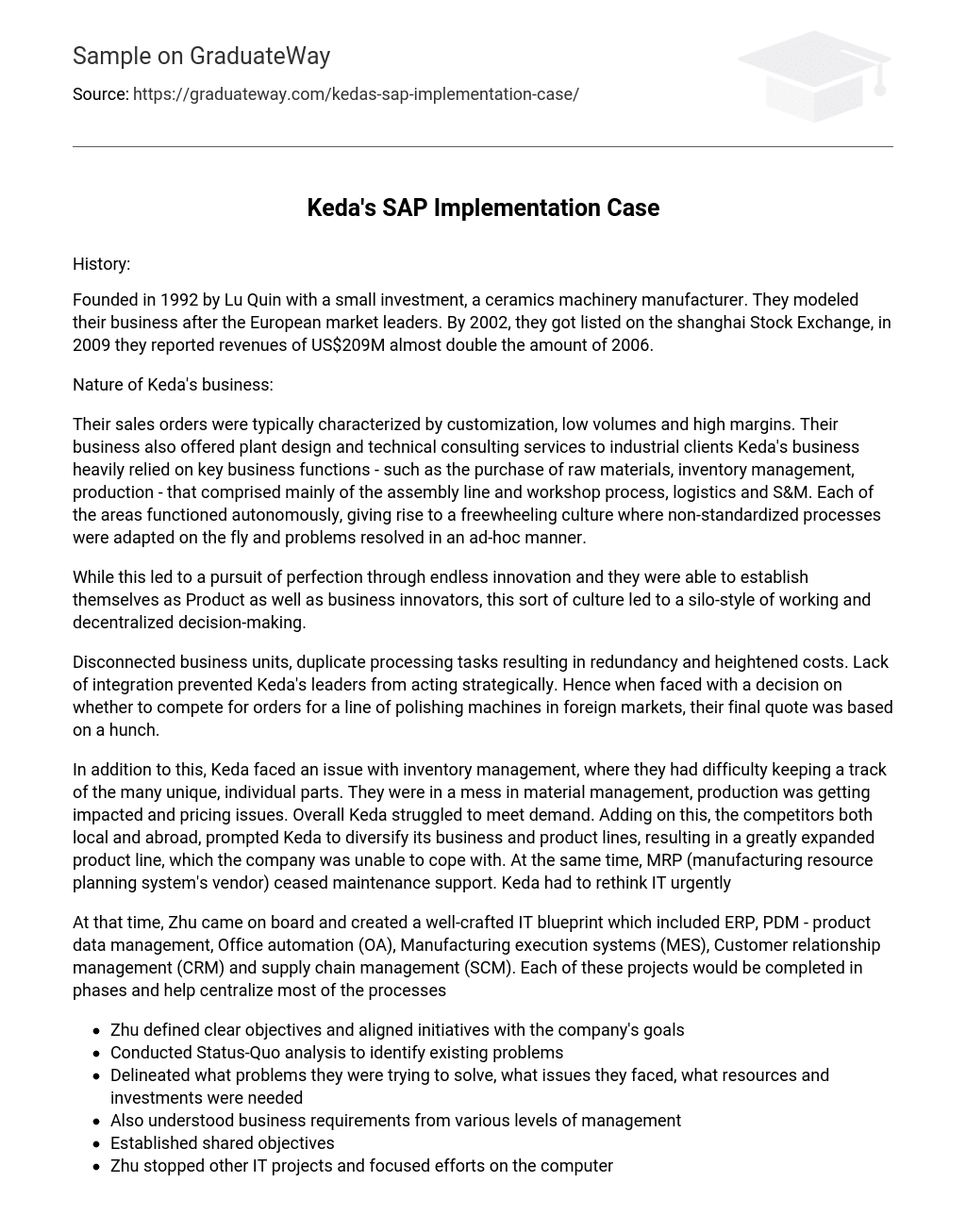History:
Founded in 1992 by Lu Quin with a small investment, a ceramics machinery manufacturer. They modeled their business after the European market leaders. By 2002, they got listed on the shanghai Stock Exchange, in 2009 they reported revenues of US$209M almost double the amount of 2006.
Nature of Keda’s business:
Their sales orders were typically characterized by customization, low volumes and high margins. Their business also offered plant design and technical consulting services to industrial clients Keda’s business heavily relied on key business functions – such as the purchase of raw materials, inventory management, production – that comprised mainly of the assembly line and workshop process, logistics and S&M. Each of the areas functioned autonomously, giving rise to a freewheeling culture where non-standardized processes were adapted on the fly and problems resolved in an ad-hoc manner.
While this led to a pursuit of perfection through endless innovation and they were able to establish themselves as Product as well as business innovators, this sort of culture led to a silo-style of working and decentralized decision-making.
Disconnected business units, duplicate processing tasks resulting in redundancy and heightened costs. Lack of integration prevented Keda’s leaders from acting strategically. Hence when faced with a decision on whether to compete for orders for a line of polishing machines in foreign markets, their final quote was based on a hunch.
In addition to this, Keda faced an issue with inventory management, where they had difficulty keeping a track of the many unique, individual parts. They were in a mess in material management, production was getting impacted and pricing issues. Overall Keda struggled to meet demand. Adding on this, the competitors both local and abroad, prompted Keda to diversify its business and product lines, resulting in a greatly expanded product line, which the company was unable to cope with. At the same time, MRP (manufacturing resource planning system’s vendor) ceased maintenance support. Keda had to rethink IT urgently
At that time, Zhu came on board and created a well-crafted IT blueprint which included ERP, PDM – product data management, Office automation (OA), Manufacturing execution systems (MES), Customer relationship management (CRM) and supply chain management (SCM). Each of these projects would be completed in phases and help centralize most of the processes
- Zhu defined clear objectives and aligned initiatives with the company’s goals
- Conducted Status-Quo analysis to identify existing problems
- Delineated what problems they were trying to solve, what issues they faced, what resources and investments were needed
- Also understood business requirements from various levels of management
- Established shared objectives
- Zhu stopped other IT projects and focused efforts on the computerization plan
- Also prioritized objectives according to the urgency
Zhu aimed for improvement in:
- Management control
- Information quality
Process of choosing an ERP vendor
- Vendor invited to visit Keda and understand the objectives and needs of Keda
- This also allowed Keda’s managers to learn more about information systems and information technology
- Visited the existing clients of the ERP vendors
- Allowed Keda to gain insights on the vendors and also possible complications in the implementation process
- Keda could avoid the mistakes made by other companies
- Zhu defined what Keda needed and hence had clear selection criteria for the ERP vendor (See exhibit 2)
- Scalability of the system
- Support of multiple production plants
- Reputation of vendor
- Ability to generate reports
- Consulting services and maintenance support is available
- The overall cost is given functionality
- Whether or not the system can effectively function in the Chinese market and context
- Zhu eventually decided on the SAP ERP
- Feature-rich
- Industry leader with “35 years of experience and good track record of successful implementations”
- SACMI (Keda’s major competitor) uses SAP ERP as well
- Decided to outsource anything outside of Keda’s core business and competencies





